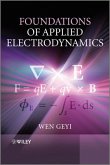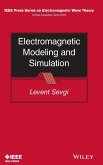Julius Adams Stratton
Electromagnetic Theory
Julius Adams Stratton
Electromagnetic Theory
- Gebundenes Buch
- Merkliste
- Auf die Merkliste
- Bewerten Bewerten
- Teilen
- Produkt teilen
- Produkterinnerung
- Produkterinnerung
First published in 1941, Julius Stratton's classic Electromagnetic Theory has been a mainstay for generations of students, researchers, and scientists. This classic reissue of the original features a Foreword to the Classic Reissue by Dr. Donald G. Dudley that details the book's contribution to the field and an introductory biography by Dr. Paul E. Gray, former MIT President and colleague of Dr. Stratton. This respected and frequently cited text remains as useful and relevant as ever, with areas of particular interest to today's students and researchers that include: * The discussion of Hansen…mehr
Andere Kunden interessierten sich auch für
![Foundations of Applied Electrodynamics Foundations of Applied Electrodynamics]() Wen GeyiFoundations of Applied Electrodynamics137,99 €
Wen GeyiFoundations of Applied Electrodynamics137,99 €![Electromagnetic Fields 2E Electromagnetic Fields 2E]() Jean G. Van BladelElectromagnetic Fields 2E253,99 €
Jean G. Van BladelElectromagnetic Fields 2E253,99 €![Electromagnetic Modeling and Simulation Electromagnetic Modeling and Simulation]() Levent SevgiElectromagnetic Modeling and Simulation160,99 €
Levent SevgiElectromagnetic Modeling and Simulation160,99 €![Modern Electromagnetic Scattering Theory with Applications Modern Electromagnetic Scattering Theory with Applications]() Andrey A. OsipovModern Electromagnetic Scattering Theory with Applications212,99 €
Andrey A. OsipovModern Electromagnetic Scattering Theory with Applications212,99 €![Electromagnetic Computation Methods for Lightning Surge Protection Studies Electromagnetic Computation Methods for Lightning Surge Protection Studies]() Yoshihiro BabaElectromagnetic Computation Methods for Lightning Surge Protection Studies190,99 €
Yoshihiro BabaElectromagnetic Computation Methods for Lightning Surge Protection Studies190,99 €![Anechoic and Reverberation Chambers Anechoic and Reverberation Chambers]() Qian XuAnechoic and Reverberation Chambers149,99 €
Qian XuAnechoic and Reverberation Chambers149,99 €![Discontinuities in the Electromagnetic Field Discontinuities in the Electromagnetic Field]() M. Mithat IdemenDiscontinuities in the Electromagnetic Field150,99 €
M. Mithat IdemenDiscontinuities in the Electromagnetic Field150,99 €-
-
-
First published in 1941, Julius Stratton's classic Electromagnetic Theory has been a mainstay for generations of students, researchers, and scientists. This classic reissue of the original features a Foreword to the Classic Reissue by Dr. Donald G. Dudley that details the book's contribution to the field and an introductory biography by Dr. Paul E. Gray, former MIT President and colleague of Dr. Stratton. This respected and frequently cited text remains as useful and relevant as ever, with areas of particular interest to today's students and researchers that include: * The discussion of Hansen vector wave functions * The outstanding treatment of phase and group velocity * The Stratton-Chu formulation for integration of the vector Helmholtz equations * The development of the source-free solutions for a circular cylinder in a lossy medium * The treatment of spherical vector wave expansions The IEEE Press Series on Electromagnetic Wave Theory offers outstanding coverage of the field. It consists of new titles of contemporary interest as well as reissues and revisions of recognized classics by established authors and researchers. The series emphasizes works of long-term archival significance in electromagnetic waves and applications. Designed especially for graduate students, researchers, and practicing engineers, the series provides affordable volumes that explore and explain electromagnetics waves beyond the undergraduate level.
Hinweis: Dieser Artikel kann nur an eine deutsche Lieferadresse ausgeliefert werden.
Hinweis: Dieser Artikel kann nur an eine deutsche Lieferadresse ausgeliefert werden.
Produktdetails
- Produktdetails
- Verlag: John Wiley & Sons / Wiley
- Seitenzahl: 640
- Erscheinungstermin: 22. Januar 2007
- Englisch
- Abmessung: 240mm x 161mm x 39mm
- Gewicht: 1117g
- ISBN-13: 9780470131534
- ISBN-10: 0470131535
- Artikelnr.: 21357995
- Herstellerkennzeichnung
- Libri GmbH
- Europaallee 1
- 36244 Bad Hersfeld
- gpsr@libri.de
- Verlag: John Wiley & Sons / Wiley
- Seitenzahl: 640
- Erscheinungstermin: 22. Januar 2007
- Englisch
- Abmessung: 240mm x 161mm x 39mm
- Gewicht: 1117g
- ISBN-13: 9780470131534
- ISBN-10: 0470131535
- Artikelnr.: 21357995
- Herstellerkennzeichnung
- Libri GmbH
- Europaallee 1
- 36244 Bad Hersfeld
- gpsr@libri.de
JULIUS ADAMS STRATTON (1901-1994) had an SB, 1923, and SM, 1926, in electrical engineering, Massachusetts Institute of Technology; an ScD in mathematical physics, 1928, Eidgenossiche Technische Hochshule, Zurich, Switzerland; and was the eleventh president of MIT. Much of his research at MIT focused on the propagation of short electromagnetic waves. During World War II, he worked on the development of LORAN (Long Range Navigation) for planes and ships. He served as a consultant to Secretary of War Henry L. Stimson and chaired committees to improve all-weather flying systems and ground radar, fire control, and radar bombing equipment. He also helped plan the use of radar in the Normandy invasion. He was awarded the Medal of Merit for his services. He became MIT's first chancellor in 1956, acting president in 1957, and president in 1959. At his retirement in 1966, he was elected a life member of the MIT Corporation. A trustee of the Ford Foundation from 1955-1971, he served as its chairman from 1966 to 1971.
Preface.
CHAPTER I: THE FIELD EQUATIONS.
MAXWELL'S EQUATIONS.
1.1 The Field Vectors.
1.2 Charge and Current.
1.3 Divergence of the Field Vectors.
1.4 Integral Form of the Field Equations.
MACROSCOPIC PROPERTIES OF MATTER.
1.5 The Inductive Capacities c and p.
1.6 Electric and Magnetic Polarization.
1.7 Conducting Media.
UNITS AND DIMENSIONS.
1.8 M.K.S. or Giorgi System.
THE ELECTROMAGNETIC POTENTIALS.
1.9 Vector and Scalar Potentials.
1.10 Conducting Media.
1.11 Hertz Vectors, or Polarization Potentials.
1.12 Complex Field Vectors and Potentials.
BOUNDARY CONDITIONS.
1.13 Discontinuities in the Field Vectors.
COORDINATE SYSTEMS.
1.14 Unitary and Reciprocal Vectors.
1.15 Differential Operators.
1.16 Orthogonal Systems.
1.17 Field Equations in General Orthogonal Coordinates.
1.18 Properties of Some Elementary Systems.
THE FIELD SENSORS.
1.19 Orthogonal Transformations and Their Invariants.
1.20 Elements of Tensor Analysis.
1.21 Space-time Symmetry of the Field Equations.
1.22 The Lorentz Transformation.
1.23 Transformation of the Field Vectors to Moving Systems.
CHAPTER II: STRESS AND ENERGY.
STRESS AND STRAIN IN ELASTIC MEDIA.
2.1 Elastic Stress Tensor.
2.2 Analysis of Strain.
2.3 Elastic Energy and the Relations of Stress to Strain.
ELECTROMAGNETIC FORCES ON CHARGES AND CURRENTS.
2.4 Definition of the Vectors E and B.
2.5 Electromagnetic Stress Tensor in Free Space.
2.6 Electromagnetic Momentum.
2.7 Electrostatic Energy as a Function of Charge Density.
2.8 Electrostatic Energy as a Function of Field Intensity.
2 3 A Theorem on Vector Fields.
2.10 Energy of a Dielectric Body in an Electrostatic Field.
2.11 Thornson's Theorem.
2.12 Earnshaw's Theorem.
2.13 Theorem on the Energy of Uncharged Conductors.
MAGNETOSTATIC ENERGY.
2.14 Magnetic Energy of Stationary Currents.
2.15 Magnetic Energy as a Function of Field Intensity.
2.16 Ferromagnetic Materials.
2.17 Energy of a Magnetic Body in a Magnetostatic Field.
2.18 Potential Energy of a Permanent Magnet.
ENERGY FLOW.
2.19 Poynting's Theorem.
2.20 Complex Poynting Vector.
FORCES ON A DIELECTRIC IN AN ELECTROSTATIC FIELD.
2.21 Body Forces in Fluids.
2.22 Body Forces in Solids.
2.23 The Stress Tensor.
2.24 Surfaces of Discontinuity.
2.25 Electrostriction.
2.26 Force on a Body Immersed in a Fluid.
FORCES IN THE MAGNETOSTATIC FIELD.
2.27 Nonferromagnetic Materials.
2.28 Ferromagnetic Materials.
FORCES IN THE ELECTROMAGNETIC FIELD.
2.29 Force on a Body Immersed in a Fluid.
CHAPTER III: THE ELECTROSTATIC FIELD.
3.1 Equations of Field and Potential.
3.2 Boundary Conditions.
CALCULATION OF THE FIELD FROM THE CHARGE DISTRIBUTION.
3.3 Green's Theorem.
3.4 Integration of Poisson's Equation.
3.5 Behavior at Infinity.
3.6 Coulomb Field.
3.7 Convergence of Integrals.
EXPANSION OF THE POTENTIAL IN SPHERICAL HARMONICS.
3.8 Axial Distributions of Charge.
3.9 The Dipole.
3.10 Axial Multipoles.
3.11 Arbitrary Distributions of Charge.
3.12 General Theory of Multipoles.
DIELECTRIC POLARIZATION.
3.13 Interpretation of the Vectors P and IT.
3.14 Volume Distributions of Charge and Dipole Moment.
3.15 Single-layer Charge Distributions.
3.16 Double-layer Distributions.
3.17 Interpretation of Green's Theorem.
3.18 Images.
BOUNDARY-VALUE PROBLEMS.
3.19 Formulation of Electrostatic Problems.
3.20 Uniqueness of Solution.
3.21 Solution of Laplace's Equation.
PROBLEM OF THE SPHERE.
3.22 Conducting Sphere in Field of a Point Charge
3.23 Dielectric Sphere in Field of a Point Charge
3.24 Sphere in a Parallel Field
3.25 Free Charge on a Conducting Ellipsoid.
3.26 Conducting Ellipsoid in a Parallel Field.
3.27 Dielectric Ellipsoid in a Parallel Field.
3.28 Cavity Definitions of E and D.
3.29 Torque Exerted on an Ellipsoid.
CHAPTER IV: THE MAGNETOSTATIC FIELD.
GENERAL PROPERTIES OF A MAGNETOSTATFIC FIELD.
4.1 Field Equations and the Vector Potential.
4.2 Scalar Potential.
4.3 Poisson's Analysis.
CALCULATION OF THE FIELD OF A CURRENT DISTRIBUTION.
4.4 Biot-Savart Law.
4.5 Expansion of the Vector Potential.
4.6 The Magnetic Dipole.
4.7 Magnetic Shells.
A DIGRESSION ON UNITS AND DIMENSIONS.
4.8 Fundamental Systems.
4.9 Coulomb's Law for Magnetic Matter.
MAGNETIC POLARIZATION.
4.10 Equivalent Current Distributions
4.11 Field of hfagnetized Rods and Spheres
DISCONTINUITIES OF THE VECTORS A AND B.
4.12 Surface Distributions of Current.
4.13 Surface Distributions of Magnetic Moment.
INTEGRATION OF THE EQUATION.
4.14 Vector Analogue of Green's Theorem.
4.15 Application to the Vector Potential.
BOUNDARY-VALUE PROBLEMS.
4.16 Formulation of the Magnetostatic Problem.
4.17 Uniqueness of Solution.
PROBLEM OF THE ELLIPSOID.
4.18 Field of a Uniformly Magnetized Ellipsoid.
4.19 Magnetic Ellipsoid in a Parallel Field.
CYLINDER IN A PARALLEL FIELD.
4.20 Calculation of the Field.
4.21 Force Exerted on the Cylinder.
PROBLEMS.
CHAPTER V: PLANE WAVES IN UNBOUNDED ISOTROPIC MEDIA.
PROPAGATION OF PLANE WAVES.
5.1 Equations of a One-dimensional Field.
5.2 Plane Waves Harmonic in Time.
5.3 Plane Waves Harmonic in Space.
5.4 Polarization.
5.5 Energy Flow.
5.6 Impedance.
GENERAL SOLUTIONS OF THE ONE-DIMENSION WAVE EQUATION.
5.7 Elements of Fourier Analysis.
5.8 General Solution of the One-dimensional Wave Equation in a
Nondissipative Medium.
5.9 Dissipative Medium; Prescribed Distribution in Time.
5.10 Dissipative Medium; Prescribed Distribution in Space.
5.11 Discussion of a Numerical Example.
5.12 Elementary Theory of the Laplace Transformation.
5.13 Application of the Laplace Transformation to Maxwell's Equations.18
DISPERSION.
5.14 Dispersion in Dielectrics.
5.15 Dispersion in Metals.
5.16 Propagation in an Ionized Atmosphere.
VELOCITIES OF PROPAGATION.
5.17 Group Velocity.
5.18 Wave-front and Signal Velocities.
PROBLEMS.
CHAPTER VI: CYLINDRICAL WAVES.
EQUATIONS OF A CYLINDRICAL FIE LD.
6.1 Representation by Hertz Vectors.
6.2 Scalar and Vector Potentials.
6.3 Impedances of Harmonic Cylindrical Fields.
WAVE FUNCTIONS OF THE CIRCULAR CYLINDER.
6.4 Elementary Waves.
6.5 Properties of the Functions Zp(p).
6.6 The Field of Circularly Cylindrical Wave Functions.
6.7 Construction from Plane Wave Solutions.
6.8 Integral Representations of the Functions Zp(p).
6.9 Fourier-Bessel Integrals.
6.10 Representation of a Plane Wave.
6.11 The Addition Theorem for Circularly Cylindrical Waves.
WAVE FUNCTIONS OF THE ELLIPTIC CYLINDER.
6.12 Elementary Waves.
6.13 Integral Representations.
6.14 Expansion of Plane and Circular Waves.
PROBLEMS.
CHAPTER VII: SPHERICAL WAVES.
THE VECTOR WAVE EQUATION.
7.1 A Fundamental Set of Solutions.
7.2 Application to Cylindrical Coordinates.
THE SCALAR WAVE EQUATION IN SPHERICAL COORDINATES.
7.3 Elementary Spherical Waves.
7.4 Properties of the Radial Functions.
7.5 Addition Theorem for the Legendre Polynomials.
7.6 Expansion of Plane Waves.
7.7 Integral Representations.
7.8 A Fourier-Bessel Integral.
7.9 Expansion of a Cylindrical Wave Function.
7.10 Addition Theorem for zp(kR).
THE VECTOR WAVE EQUATION IN SPHERICACL COORDINATES.
7.11 Spherical Vector Wave Functions.
7.12 Integral Representations.
7.13 Orthogonality.
7.14 Expansion of a Vector Plane Wave.
PROBLEMS.
CHAPTER VIII: RADIATION.
THE INHOMOGENEOUS SOLAR WAVE EQUATION.
8.1 Kirchhoff Method of Integration.
8.2 Retarded Potentials.
8.3 Retarded Hertz Vector.
A MULTIPOLE EXPANSION.
8.4 Definition of the Moments.
8.5 Electric Dipole.
8.6 Magnetic Dipole.
RADIATION THEORY OF LINEAR ANTENNA SYSTEMS.
8.7 Radiation Field of a Single Linear Oscillator.
8.8 Radiation Due to Traveling Waves.
8.9 Suppression of Alternate Phases.
8.10 Directional Arrays.
8.11 Exact Calculation of the Field of a Linear Oscillator.
8.12 Radiation Resistance by the E.M.F. Method.
THE KIRCHHOFF-HUYGENS PRINCIPLE.
8.13 Scalar Wave Functions.
8.14 Direct Integration of the Field Equations.
8.15 Discontinuous Surface Distributions.
FOUR-DIMENSIONAL FORMULATION OF THE RADIATION PROBLEM.
8.16 Integration of the Wave Equation.
8.17 Field of a Moving Point Charge.
PROBLEMS.
CHAPTER IX: BOUNDARY-VALUE PROBLEMS.
GENERAL THEOREMS.
9.1 Boundary Conditions.
9.2 Uniqueness of Solution.
9.3 Electrodynamic Similitude.
REFLECTION AND REFRACTION AT A PLANE SURFACE.
9.4 Snell's Laws.
9.5 Fresnel's Equations.
9.6 Dielectric Media.
9.7 Total Reflection.
9.8 Refraction in a Conducting Medium.
9.9 Reflection at a Conducting Surface.
PLANE SHEETS.
9.10 Reflection and Transmission Coefficients.
9.11 Application to Dielectric Media.
9.12 Ahsorbing Layers.
SURFACE WAVES.
9.13 Complex Angles of Incidence
9.14 Skin Effect.
PROPAGATION ALONG A CIRCULAR CYLINDER.
9 15 Natural Modes.
9 16 Conductor Ernbeded in a Dielectric.
9 17 Further Discussion of the Principal Wave.
9 18 Waves in Hollow Pipes.
COAXIA LINES.
9.19 Propagation Constant.
9.20 Infinite Conductivity.
9.21 Finite Conductivity.
OSCILLATIONS OF A SPHERE.
9.22 Natural Modes.
9.23 Oscillations of a Conducting Sphere.
9.24 Oscillations in a Spherical Cavity.
DIFFRACTION OF A PLANE WAVE BY A SPHERE.
9.25 Expansion of the Diffracted Field.
9.26 Total Radiation.
9.27 Limiting Cases.
EFFECT OF THE EARTH ON THE PROPAGATION OF RADIO WAVES.
9.28 Sommerfeld Solution.
9.29 Weyl Solution.
9.30 van der Pol Solution.
9.31 Approximation of the Integrals.
PROBLEMS.
APPENDIX I.
A. NUMERICAL VALUES OF FUNDAMENTAL CONSTANTS.
B. DIMENSIONS OF ELECTROMAGNETIC QUANTITIES.
C. CONVERSION TABLES.
APPENDIX II.
FORMULAS FROM VECTOR ANALYSIS.
APPENDIX III.
CONDUCTIVITY OF VARIOUS MATERIALS.
SPECIFIC INDUCTIVE CAPACITY OF DIELECTRICS.
APPENDIX IV.
ASSOCIATED LEGENDRE FUNCTIONS.
Index.
CHAPTER I: THE FIELD EQUATIONS.
MAXWELL'S EQUATIONS.
1.1 The Field Vectors.
1.2 Charge and Current.
1.3 Divergence of the Field Vectors.
1.4 Integral Form of the Field Equations.
MACROSCOPIC PROPERTIES OF MATTER.
1.5 The Inductive Capacities c and p.
1.6 Electric and Magnetic Polarization.
1.7 Conducting Media.
UNITS AND DIMENSIONS.
1.8 M.K.S. or Giorgi System.
THE ELECTROMAGNETIC POTENTIALS.
1.9 Vector and Scalar Potentials.
1.10 Conducting Media.
1.11 Hertz Vectors, or Polarization Potentials.
1.12 Complex Field Vectors and Potentials.
BOUNDARY CONDITIONS.
1.13 Discontinuities in the Field Vectors.
COORDINATE SYSTEMS.
1.14 Unitary and Reciprocal Vectors.
1.15 Differential Operators.
1.16 Orthogonal Systems.
1.17 Field Equations in General Orthogonal Coordinates.
1.18 Properties of Some Elementary Systems.
THE FIELD SENSORS.
1.19 Orthogonal Transformations and Their Invariants.
1.20 Elements of Tensor Analysis.
1.21 Space-time Symmetry of the Field Equations.
1.22 The Lorentz Transformation.
1.23 Transformation of the Field Vectors to Moving Systems.
CHAPTER II: STRESS AND ENERGY.
STRESS AND STRAIN IN ELASTIC MEDIA.
2.1 Elastic Stress Tensor.
2.2 Analysis of Strain.
2.3 Elastic Energy and the Relations of Stress to Strain.
ELECTROMAGNETIC FORCES ON CHARGES AND CURRENTS.
2.4 Definition of the Vectors E and B.
2.5 Electromagnetic Stress Tensor in Free Space.
2.6 Electromagnetic Momentum.
2.7 Electrostatic Energy as a Function of Charge Density.
2.8 Electrostatic Energy as a Function of Field Intensity.
2 3 A Theorem on Vector Fields.
2.10 Energy of a Dielectric Body in an Electrostatic Field.
2.11 Thornson's Theorem.
2.12 Earnshaw's Theorem.
2.13 Theorem on the Energy of Uncharged Conductors.
MAGNETOSTATIC ENERGY.
2.14 Magnetic Energy of Stationary Currents.
2.15 Magnetic Energy as a Function of Field Intensity.
2.16 Ferromagnetic Materials.
2.17 Energy of a Magnetic Body in a Magnetostatic Field.
2.18 Potential Energy of a Permanent Magnet.
ENERGY FLOW.
2.19 Poynting's Theorem.
2.20 Complex Poynting Vector.
FORCES ON A DIELECTRIC IN AN ELECTROSTATIC FIELD.
2.21 Body Forces in Fluids.
2.22 Body Forces in Solids.
2.23 The Stress Tensor.
2.24 Surfaces of Discontinuity.
2.25 Electrostriction.
2.26 Force on a Body Immersed in a Fluid.
FORCES IN THE MAGNETOSTATIC FIELD.
2.27 Nonferromagnetic Materials.
2.28 Ferromagnetic Materials.
FORCES IN THE ELECTROMAGNETIC FIELD.
2.29 Force on a Body Immersed in a Fluid.
CHAPTER III: THE ELECTROSTATIC FIELD.
3.1 Equations of Field and Potential.
3.2 Boundary Conditions.
CALCULATION OF THE FIELD FROM THE CHARGE DISTRIBUTION.
3.3 Green's Theorem.
3.4 Integration of Poisson's Equation.
3.5 Behavior at Infinity.
3.6 Coulomb Field.
3.7 Convergence of Integrals.
EXPANSION OF THE POTENTIAL IN SPHERICAL HARMONICS.
3.8 Axial Distributions of Charge.
3.9 The Dipole.
3.10 Axial Multipoles.
3.11 Arbitrary Distributions of Charge.
3.12 General Theory of Multipoles.
DIELECTRIC POLARIZATION.
3.13 Interpretation of the Vectors P and IT.
3.14 Volume Distributions of Charge and Dipole Moment.
3.15 Single-layer Charge Distributions.
3.16 Double-layer Distributions.
3.17 Interpretation of Green's Theorem.
3.18 Images.
BOUNDARY-VALUE PROBLEMS.
3.19 Formulation of Electrostatic Problems.
3.20 Uniqueness of Solution.
3.21 Solution of Laplace's Equation.
PROBLEM OF THE SPHERE.
3.22 Conducting Sphere in Field of a Point Charge
3.23 Dielectric Sphere in Field of a Point Charge
3.24 Sphere in a Parallel Field
3.25 Free Charge on a Conducting Ellipsoid.
3.26 Conducting Ellipsoid in a Parallel Field.
3.27 Dielectric Ellipsoid in a Parallel Field.
3.28 Cavity Definitions of E and D.
3.29 Torque Exerted on an Ellipsoid.
CHAPTER IV: THE MAGNETOSTATIC FIELD.
GENERAL PROPERTIES OF A MAGNETOSTATFIC FIELD.
4.1 Field Equations and the Vector Potential.
4.2 Scalar Potential.
4.3 Poisson's Analysis.
CALCULATION OF THE FIELD OF A CURRENT DISTRIBUTION.
4.4 Biot-Savart Law.
4.5 Expansion of the Vector Potential.
4.6 The Magnetic Dipole.
4.7 Magnetic Shells.
A DIGRESSION ON UNITS AND DIMENSIONS.
4.8 Fundamental Systems.
4.9 Coulomb's Law for Magnetic Matter.
MAGNETIC POLARIZATION.
4.10 Equivalent Current Distributions
4.11 Field of hfagnetized Rods and Spheres
DISCONTINUITIES OF THE VECTORS A AND B.
4.12 Surface Distributions of Current.
4.13 Surface Distributions of Magnetic Moment.
INTEGRATION OF THE EQUATION.
4.14 Vector Analogue of Green's Theorem.
4.15 Application to the Vector Potential.
BOUNDARY-VALUE PROBLEMS.
4.16 Formulation of the Magnetostatic Problem.
4.17 Uniqueness of Solution.
PROBLEM OF THE ELLIPSOID.
4.18 Field of a Uniformly Magnetized Ellipsoid.
4.19 Magnetic Ellipsoid in a Parallel Field.
CYLINDER IN A PARALLEL FIELD.
4.20 Calculation of the Field.
4.21 Force Exerted on the Cylinder.
PROBLEMS.
CHAPTER V: PLANE WAVES IN UNBOUNDED ISOTROPIC MEDIA.
PROPAGATION OF PLANE WAVES.
5.1 Equations of a One-dimensional Field.
5.2 Plane Waves Harmonic in Time.
5.3 Plane Waves Harmonic in Space.
5.4 Polarization.
5.5 Energy Flow.
5.6 Impedance.
GENERAL SOLUTIONS OF THE ONE-DIMENSION WAVE EQUATION.
5.7 Elements of Fourier Analysis.
5.8 General Solution of the One-dimensional Wave Equation in a
Nondissipative Medium.
5.9 Dissipative Medium; Prescribed Distribution in Time.
5.10 Dissipative Medium; Prescribed Distribution in Space.
5.11 Discussion of a Numerical Example.
5.12 Elementary Theory of the Laplace Transformation.
5.13 Application of the Laplace Transformation to Maxwell's Equations.18
DISPERSION.
5.14 Dispersion in Dielectrics.
5.15 Dispersion in Metals.
5.16 Propagation in an Ionized Atmosphere.
VELOCITIES OF PROPAGATION.
5.17 Group Velocity.
5.18 Wave-front and Signal Velocities.
PROBLEMS.
CHAPTER VI: CYLINDRICAL WAVES.
EQUATIONS OF A CYLINDRICAL FIE LD.
6.1 Representation by Hertz Vectors.
6.2 Scalar and Vector Potentials.
6.3 Impedances of Harmonic Cylindrical Fields.
WAVE FUNCTIONS OF THE CIRCULAR CYLINDER.
6.4 Elementary Waves.
6.5 Properties of the Functions Zp(p).
6.6 The Field of Circularly Cylindrical Wave Functions.
6.7 Construction from Plane Wave Solutions.
6.8 Integral Representations of the Functions Zp(p).
6.9 Fourier-Bessel Integrals.
6.10 Representation of a Plane Wave.
6.11 The Addition Theorem for Circularly Cylindrical Waves.
WAVE FUNCTIONS OF THE ELLIPTIC CYLINDER.
6.12 Elementary Waves.
6.13 Integral Representations.
6.14 Expansion of Plane and Circular Waves.
PROBLEMS.
CHAPTER VII: SPHERICAL WAVES.
THE VECTOR WAVE EQUATION.
7.1 A Fundamental Set of Solutions.
7.2 Application to Cylindrical Coordinates.
THE SCALAR WAVE EQUATION IN SPHERICAL COORDINATES.
7.3 Elementary Spherical Waves.
7.4 Properties of the Radial Functions.
7.5 Addition Theorem for the Legendre Polynomials.
7.6 Expansion of Plane Waves.
7.7 Integral Representations.
7.8 A Fourier-Bessel Integral.
7.9 Expansion of a Cylindrical Wave Function.
7.10 Addition Theorem for zp(kR).
THE VECTOR WAVE EQUATION IN SPHERICACL COORDINATES.
7.11 Spherical Vector Wave Functions.
7.12 Integral Representations.
7.13 Orthogonality.
7.14 Expansion of a Vector Plane Wave.
PROBLEMS.
CHAPTER VIII: RADIATION.
THE INHOMOGENEOUS SOLAR WAVE EQUATION.
8.1 Kirchhoff Method of Integration.
8.2 Retarded Potentials.
8.3 Retarded Hertz Vector.
A MULTIPOLE EXPANSION.
8.4 Definition of the Moments.
8.5 Electric Dipole.
8.6 Magnetic Dipole.
RADIATION THEORY OF LINEAR ANTENNA SYSTEMS.
8.7 Radiation Field of a Single Linear Oscillator.
8.8 Radiation Due to Traveling Waves.
8.9 Suppression of Alternate Phases.
8.10 Directional Arrays.
8.11 Exact Calculation of the Field of a Linear Oscillator.
8.12 Radiation Resistance by the E.M.F. Method.
THE KIRCHHOFF-HUYGENS PRINCIPLE.
8.13 Scalar Wave Functions.
8.14 Direct Integration of the Field Equations.
8.15 Discontinuous Surface Distributions.
FOUR-DIMENSIONAL FORMULATION OF THE RADIATION PROBLEM.
8.16 Integration of the Wave Equation.
8.17 Field of a Moving Point Charge.
PROBLEMS.
CHAPTER IX: BOUNDARY-VALUE PROBLEMS.
GENERAL THEOREMS.
9.1 Boundary Conditions.
9.2 Uniqueness of Solution.
9.3 Electrodynamic Similitude.
REFLECTION AND REFRACTION AT A PLANE SURFACE.
9.4 Snell's Laws.
9.5 Fresnel's Equations.
9.6 Dielectric Media.
9.7 Total Reflection.
9.8 Refraction in a Conducting Medium.
9.9 Reflection at a Conducting Surface.
PLANE SHEETS.
9.10 Reflection and Transmission Coefficients.
9.11 Application to Dielectric Media.
9.12 Ahsorbing Layers.
SURFACE WAVES.
9.13 Complex Angles of Incidence
9.14 Skin Effect.
PROPAGATION ALONG A CIRCULAR CYLINDER.
9 15 Natural Modes.
9 16 Conductor Ernbeded in a Dielectric.
9 17 Further Discussion of the Principal Wave.
9 18 Waves in Hollow Pipes.
COAXIA LINES.
9.19 Propagation Constant.
9.20 Infinite Conductivity.
9.21 Finite Conductivity.
OSCILLATIONS OF A SPHERE.
9.22 Natural Modes.
9.23 Oscillations of a Conducting Sphere.
9.24 Oscillations in a Spherical Cavity.
DIFFRACTION OF A PLANE WAVE BY A SPHERE.
9.25 Expansion of the Diffracted Field.
9.26 Total Radiation.
9.27 Limiting Cases.
EFFECT OF THE EARTH ON THE PROPAGATION OF RADIO WAVES.
9.28 Sommerfeld Solution.
9.29 Weyl Solution.
9.30 van der Pol Solution.
9.31 Approximation of the Integrals.
PROBLEMS.
APPENDIX I.
A. NUMERICAL VALUES OF FUNDAMENTAL CONSTANTS.
B. DIMENSIONS OF ELECTROMAGNETIC QUANTITIES.
C. CONVERSION TABLES.
APPENDIX II.
FORMULAS FROM VECTOR ANALYSIS.
APPENDIX III.
CONDUCTIVITY OF VARIOUS MATERIALS.
SPECIFIC INDUCTIVE CAPACITY OF DIELECTRICS.
APPENDIX IV.
ASSOCIATED LEGENDRE FUNCTIONS.
Index.
Preface.
CHAPTER I: THE FIELD EQUATIONS.
MAXWELL'S EQUATIONS.
1.1 The Field Vectors.
1.2 Charge and Current.
1.3 Divergence of the Field Vectors.
1.4 Integral Form of the Field Equations.
MACROSCOPIC PROPERTIES OF MATTER.
1.5 The Inductive Capacities c and p.
1.6 Electric and Magnetic Polarization.
1.7 Conducting Media.
UNITS AND DIMENSIONS.
1.8 M.K.S. or Giorgi System.
THE ELECTROMAGNETIC POTENTIALS.
1.9 Vector and Scalar Potentials.
1.10 Conducting Media.
1.11 Hertz Vectors, or Polarization Potentials.
1.12 Complex Field Vectors and Potentials.
BOUNDARY CONDITIONS.
1.13 Discontinuities in the Field Vectors.
COORDINATE SYSTEMS.
1.14 Unitary and Reciprocal Vectors.
1.15 Differential Operators.
1.16 Orthogonal Systems.
1.17 Field Equations in General Orthogonal Coordinates.
1.18 Properties of Some Elementary Systems.
THE FIELD SENSORS.
1.19 Orthogonal Transformations and Their Invariants.
1.20 Elements of Tensor Analysis.
1.21 Space-time Symmetry of the Field Equations.
1.22 The Lorentz Transformation.
1.23 Transformation of the Field Vectors to Moving Systems.
CHAPTER II: STRESS AND ENERGY.
STRESS AND STRAIN IN ELASTIC MEDIA.
2.1 Elastic Stress Tensor.
2.2 Analysis of Strain.
2.3 Elastic Energy and the Relations of Stress to Strain.
ELECTROMAGNETIC FORCES ON CHARGES AND CURRENTS.
2.4 Definition of the Vectors E and B.
2.5 Electromagnetic Stress Tensor in Free Space.
2.6 Electromagnetic Momentum.
2.7 Electrostatic Energy as a Function of Charge Density.
2.8 Electrostatic Energy as a Function of Field Intensity.
2 3 A Theorem on Vector Fields.
2.10 Energy of a Dielectric Body in an Electrostatic Field.
2.11 Thornson's Theorem.
2.12 Earnshaw's Theorem.
2.13 Theorem on the Energy of Uncharged Conductors.
MAGNETOSTATIC ENERGY.
2.14 Magnetic Energy of Stationary Currents.
2.15 Magnetic Energy as a Function of Field Intensity.
2.16 Ferromagnetic Materials.
2.17 Energy of a Magnetic Body in a Magnetostatic Field.
2.18 Potential Energy of a Permanent Magnet.
ENERGY FLOW.
2.19 Poynting's Theorem.
2.20 Complex Poynting Vector.
FORCES ON A DIELECTRIC IN AN ELECTROSTATIC FIELD.
2.21 Body Forces in Fluids.
2.22 Body Forces in Solids.
2.23 The Stress Tensor.
2.24 Surfaces of Discontinuity.
2.25 Electrostriction.
2.26 Force on a Body Immersed in a Fluid.
FORCES IN THE MAGNETOSTATIC FIELD.
2.27 Nonferromagnetic Materials.
2.28 Ferromagnetic Materials.
FORCES IN THE ELECTROMAGNETIC FIELD.
2.29 Force on a Body Immersed in a Fluid.
CHAPTER III: THE ELECTROSTATIC FIELD.
3.1 Equations of Field and Potential.
3.2 Boundary Conditions.
CALCULATION OF THE FIELD FROM THE CHARGE DISTRIBUTION.
3.3 Green's Theorem.
3.4 Integration of Poisson's Equation.
3.5 Behavior at Infinity.
3.6 Coulomb Field.
3.7 Convergence of Integrals.
EXPANSION OF THE POTENTIAL IN SPHERICAL HARMONICS.
3.8 Axial Distributions of Charge.
3.9 The Dipole.
3.10 Axial Multipoles.
3.11 Arbitrary Distributions of Charge.
3.12 General Theory of Multipoles.
DIELECTRIC POLARIZATION.
3.13 Interpretation of the Vectors P and IT.
3.14 Volume Distributions of Charge and Dipole Moment.
3.15 Single-layer Charge Distributions.
3.16 Double-layer Distributions.
3.17 Interpretation of Green's Theorem.
3.18 Images.
BOUNDARY-VALUE PROBLEMS.
3.19 Formulation of Electrostatic Problems.
3.20 Uniqueness of Solution.
3.21 Solution of Laplace's Equation.
PROBLEM OF THE SPHERE.
3.22 Conducting Sphere in Field of a Point Charge
3.23 Dielectric Sphere in Field of a Point Charge
3.24 Sphere in a Parallel Field
3.25 Free Charge on a Conducting Ellipsoid.
3.26 Conducting Ellipsoid in a Parallel Field.
3.27 Dielectric Ellipsoid in a Parallel Field.
3.28 Cavity Definitions of E and D.
3.29 Torque Exerted on an Ellipsoid.
CHAPTER IV: THE MAGNETOSTATIC FIELD.
GENERAL PROPERTIES OF A MAGNETOSTATFIC FIELD.
4.1 Field Equations and the Vector Potential.
4.2 Scalar Potential.
4.3 Poisson's Analysis.
CALCULATION OF THE FIELD OF A CURRENT DISTRIBUTION.
4.4 Biot-Savart Law.
4.5 Expansion of the Vector Potential.
4.6 The Magnetic Dipole.
4.7 Magnetic Shells.
A DIGRESSION ON UNITS AND DIMENSIONS.
4.8 Fundamental Systems.
4.9 Coulomb's Law for Magnetic Matter.
MAGNETIC POLARIZATION.
4.10 Equivalent Current Distributions
4.11 Field of hfagnetized Rods and Spheres
DISCONTINUITIES OF THE VECTORS A AND B.
4.12 Surface Distributions of Current.
4.13 Surface Distributions of Magnetic Moment.
INTEGRATION OF THE EQUATION.
4.14 Vector Analogue of Green's Theorem.
4.15 Application to the Vector Potential.
BOUNDARY-VALUE PROBLEMS.
4.16 Formulation of the Magnetostatic Problem.
4.17 Uniqueness of Solution.
PROBLEM OF THE ELLIPSOID.
4.18 Field of a Uniformly Magnetized Ellipsoid.
4.19 Magnetic Ellipsoid in a Parallel Field.
CYLINDER IN A PARALLEL FIELD.
4.20 Calculation of the Field.
4.21 Force Exerted on the Cylinder.
PROBLEMS.
CHAPTER V: PLANE WAVES IN UNBOUNDED ISOTROPIC MEDIA.
PROPAGATION OF PLANE WAVES.
5.1 Equations of a One-dimensional Field.
5.2 Plane Waves Harmonic in Time.
5.3 Plane Waves Harmonic in Space.
5.4 Polarization.
5.5 Energy Flow.
5.6 Impedance.
GENERAL SOLUTIONS OF THE ONE-DIMENSION WAVE EQUATION.
5.7 Elements of Fourier Analysis.
5.8 General Solution of the One-dimensional Wave Equation in a
Nondissipative Medium.
5.9 Dissipative Medium; Prescribed Distribution in Time.
5.10 Dissipative Medium; Prescribed Distribution in Space.
5.11 Discussion of a Numerical Example.
5.12 Elementary Theory of the Laplace Transformation.
5.13 Application of the Laplace Transformation to Maxwell's Equations.18
DISPERSION.
5.14 Dispersion in Dielectrics.
5.15 Dispersion in Metals.
5.16 Propagation in an Ionized Atmosphere.
VELOCITIES OF PROPAGATION.
5.17 Group Velocity.
5.18 Wave-front and Signal Velocities.
PROBLEMS.
CHAPTER VI: CYLINDRICAL WAVES.
EQUATIONS OF A CYLINDRICAL FIE LD.
6.1 Representation by Hertz Vectors.
6.2 Scalar and Vector Potentials.
6.3 Impedances of Harmonic Cylindrical Fields.
WAVE FUNCTIONS OF THE CIRCULAR CYLINDER.
6.4 Elementary Waves.
6.5 Properties of the Functions Zp(p).
6.6 The Field of Circularly Cylindrical Wave Functions.
6.7 Construction from Plane Wave Solutions.
6.8 Integral Representations of the Functions Zp(p).
6.9 Fourier-Bessel Integrals.
6.10 Representation of a Plane Wave.
6.11 The Addition Theorem for Circularly Cylindrical Waves.
WAVE FUNCTIONS OF THE ELLIPTIC CYLINDER.
6.12 Elementary Waves.
6.13 Integral Representations.
6.14 Expansion of Plane and Circular Waves.
PROBLEMS.
CHAPTER VII: SPHERICAL WAVES.
THE VECTOR WAVE EQUATION.
7.1 A Fundamental Set of Solutions.
7.2 Application to Cylindrical Coordinates.
THE SCALAR WAVE EQUATION IN SPHERICAL COORDINATES.
7.3 Elementary Spherical Waves.
7.4 Properties of the Radial Functions.
7.5 Addition Theorem for the Legendre Polynomials.
7.6 Expansion of Plane Waves.
7.7 Integral Representations.
7.8 A Fourier-Bessel Integral.
7.9 Expansion of a Cylindrical Wave Function.
7.10 Addition Theorem for zp(kR).
THE VECTOR WAVE EQUATION IN SPHERICACL COORDINATES.
7.11 Spherical Vector Wave Functions.
7.12 Integral Representations.
7.13 Orthogonality.
7.14 Expansion of a Vector Plane Wave.
PROBLEMS.
CHAPTER VIII: RADIATION.
THE INHOMOGENEOUS SOLAR WAVE EQUATION.
8.1 Kirchhoff Method of Integration.
8.2 Retarded Potentials.
8.3 Retarded Hertz Vector.
A MULTIPOLE EXPANSION.
8.4 Definition of the Moments.
8.5 Electric Dipole.
8.6 Magnetic Dipole.
RADIATION THEORY OF LINEAR ANTENNA SYSTEMS.
8.7 Radiation Field of a Single Linear Oscillator.
8.8 Radiation Due to Traveling Waves.
8.9 Suppression of Alternate Phases.
8.10 Directional Arrays.
8.11 Exact Calculation of the Field of a Linear Oscillator.
8.12 Radiation Resistance by the E.M.F. Method.
THE KIRCHHOFF-HUYGENS PRINCIPLE.
8.13 Scalar Wave Functions.
8.14 Direct Integration of the Field Equations.
8.15 Discontinuous Surface Distributions.
FOUR-DIMENSIONAL FORMULATION OF THE RADIATION PROBLEM.
8.16 Integration of the Wave Equation.
8.17 Field of a Moving Point Charge.
PROBLEMS.
CHAPTER IX: BOUNDARY-VALUE PROBLEMS.
GENERAL THEOREMS.
9.1 Boundary Conditions.
9.2 Uniqueness of Solution.
9.3 Electrodynamic Similitude.
REFLECTION AND REFRACTION AT A PLANE SURFACE.
9.4 Snell's Laws.
9.5 Fresnel's Equations.
9.6 Dielectric Media.
9.7 Total Reflection.
9.8 Refraction in a Conducting Medium.
9.9 Reflection at a Conducting Surface.
PLANE SHEETS.
9.10 Reflection and Transmission Coefficients.
9.11 Application to Dielectric Media.
9.12 Ahsorbing Layers.
SURFACE WAVES.
9.13 Complex Angles of Incidence
9.14 Skin Effect.
PROPAGATION ALONG A CIRCULAR CYLINDER.
9 15 Natural Modes.
9 16 Conductor Ernbeded in a Dielectric.
9 17 Further Discussion of the Principal Wave.
9 18 Waves in Hollow Pipes.
COAXIA LINES.
9.19 Propagation Constant.
9.20 Infinite Conductivity.
9.21 Finite Conductivity.
OSCILLATIONS OF A SPHERE.
9.22 Natural Modes.
9.23 Oscillations of a Conducting Sphere.
9.24 Oscillations in a Spherical Cavity.
DIFFRACTION OF A PLANE WAVE BY A SPHERE.
9.25 Expansion of the Diffracted Field.
9.26 Total Radiation.
9.27 Limiting Cases.
EFFECT OF THE EARTH ON THE PROPAGATION OF RADIO WAVES.
9.28 Sommerfeld Solution.
9.29 Weyl Solution.
9.30 van der Pol Solution.
9.31 Approximation of the Integrals.
PROBLEMS.
APPENDIX I.
A. NUMERICAL VALUES OF FUNDAMENTAL CONSTANTS.
B. DIMENSIONS OF ELECTROMAGNETIC QUANTITIES.
C. CONVERSION TABLES.
APPENDIX II.
FORMULAS FROM VECTOR ANALYSIS.
APPENDIX III.
CONDUCTIVITY OF VARIOUS MATERIALS.
SPECIFIC INDUCTIVE CAPACITY OF DIELECTRICS.
APPENDIX IV.
ASSOCIATED LEGENDRE FUNCTIONS.
Index.
CHAPTER I: THE FIELD EQUATIONS.
MAXWELL'S EQUATIONS.
1.1 The Field Vectors.
1.2 Charge and Current.
1.3 Divergence of the Field Vectors.
1.4 Integral Form of the Field Equations.
MACROSCOPIC PROPERTIES OF MATTER.
1.5 The Inductive Capacities c and p.
1.6 Electric and Magnetic Polarization.
1.7 Conducting Media.
UNITS AND DIMENSIONS.
1.8 M.K.S. or Giorgi System.
THE ELECTROMAGNETIC POTENTIALS.
1.9 Vector and Scalar Potentials.
1.10 Conducting Media.
1.11 Hertz Vectors, or Polarization Potentials.
1.12 Complex Field Vectors and Potentials.
BOUNDARY CONDITIONS.
1.13 Discontinuities in the Field Vectors.
COORDINATE SYSTEMS.
1.14 Unitary and Reciprocal Vectors.
1.15 Differential Operators.
1.16 Orthogonal Systems.
1.17 Field Equations in General Orthogonal Coordinates.
1.18 Properties of Some Elementary Systems.
THE FIELD SENSORS.
1.19 Orthogonal Transformations and Their Invariants.
1.20 Elements of Tensor Analysis.
1.21 Space-time Symmetry of the Field Equations.
1.22 The Lorentz Transformation.
1.23 Transformation of the Field Vectors to Moving Systems.
CHAPTER II: STRESS AND ENERGY.
STRESS AND STRAIN IN ELASTIC MEDIA.
2.1 Elastic Stress Tensor.
2.2 Analysis of Strain.
2.3 Elastic Energy and the Relations of Stress to Strain.
ELECTROMAGNETIC FORCES ON CHARGES AND CURRENTS.
2.4 Definition of the Vectors E and B.
2.5 Electromagnetic Stress Tensor in Free Space.
2.6 Electromagnetic Momentum.
2.7 Electrostatic Energy as a Function of Charge Density.
2.8 Electrostatic Energy as a Function of Field Intensity.
2 3 A Theorem on Vector Fields.
2.10 Energy of a Dielectric Body in an Electrostatic Field.
2.11 Thornson's Theorem.
2.12 Earnshaw's Theorem.
2.13 Theorem on the Energy of Uncharged Conductors.
MAGNETOSTATIC ENERGY.
2.14 Magnetic Energy of Stationary Currents.
2.15 Magnetic Energy as a Function of Field Intensity.
2.16 Ferromagnetic Materials.
2.17 Energy of a Magnetic Body in a Magnetostatic Field.
2.18 Potential Energy of a Permanent Magnet.
ENERGY FLOW.
2.19 Poynting's Theorem.
2.20 Complex Poynting Vector.
FORCES ON A DIELECTRIC IN AN ELECTROSTATIC FIELD.
2.21 Body Forces in Fluids.
2.22 Body Forces in Solids.
2.23 The Stress Tensor.
2.24 Surfaces of Discontinuity.
2.25 Electrostriction.
2.26 Force on a Body Immersed in a Fluid.
FORCES IN THE MAGNETOSTATIC FIELD.
2.27 Nonferromagnetic Materials.
2.28 Ferromagnetic Materials.
FORCES IN THE ELECTROMAGNETIC FIELD.
2.29 Force on a Body Immersed in a Fluid.
CHAPTER III: THE ELECTROSTATIC FIELD.
3.1 Equations of Field and Potential.
3.2 Boundary Conditions.
CALCULATION OF THE FIELD FROM THE CHARGE DISTRIBUTION.
3.3 Green's Theorem.
3.4 Integration of Poisson's Equation.
3.5 Behavior at Infinity.
3.6 Coulomb Field.
3.7 Convergence of Integrals.
EXPANSION OF THE POTENTIAL IN SPHERICAL HARMONICS.
3.8 Axial Distributions of Charge.
3.9 The Dipole.
3.10 Axial Multipoles.
3.11 Arbitrary Distributions of Charge.
3.12 General Theory of Multipoles.
DIELECTRIC POLARIZATION.
3.13 Interpretation of the Vectors P and IT.
3.14 Volume Distributions of Charge and Dipole Moment.
3.15 Single-layer Charge Distributions.
3.16 Double-layer Distributions.
3.17 Interpretation of Green's Theorem.
3.18 Images.
BOUNDARY-VALUE PROBLEMS.
3.19 Formulation of Electrostatic Problems.
3.20 Uniqueness of Solution.
3.21 Solution of Laplace's Equation.
PROBLEM OF THE SPHERE.
3.22 Conducting Sphere in Field of a Point Charge
3.23 Dielectric Sphere in Field of a Point Charge
3.24 Sphere in a Parallel Field
3.25 Free Charge on a Conducting Ellipsoid.
3.26 Conducting Ellipsoid in a Parallel Field.
3.27 Dielectric Ellipsoid in a Parallel Field.
3.28 Cavity Definitions of E and D.
3.29 Torque Exerted on an Ellipsoid.
CHAPTER IV: THE MAGNETOSTATIC FIELD.
GENERAL PROPERTIES OF A MAGNETOSTATFIC FIELD.
4.1 Field Equations and the Vector Potential.
4.2 Scalar Potential.
4.3 Poisson's Analysis.
CALCULATION OF THE FIELD OF A CURRENT DISTRIBUTION.
4.4 Biot-Savart Law.
4.5 Expansion of the Vector Potential.
4.6 The Magnetic Dipole.
4.7 Magnetic Shells.
A DIGRESSION ON UNITS AND DIMENSIONS.
4.8 Fundamental Systems.
4.9 Coulomb's Law for Magnetic Matter.
MAGNETIC POLARIZATION.
4.10 Equivalent Current Distributions
4.11 Field of hfagnetized Rods and Spheres
DISCONTINUITIES OF THE VECTORS A AND B.
4.12 Surface Distributions of Current.
4.13 Surface Distributions of Magnetic Moment.
INTEGRATION OF THE EQUATION.
4.14 Vector Analogue of Green's Theorem.
4.15 Application to the Vector Potential.
BOUNDARY-VALUE PROBLEMS.
4.16 Formulation of the Magnetostatic Problem.
4.17 Uniqueness of Solution.
PROBLEM OF THE ELLIPSOID.
4.18 Field of a Uniformly Magnetized Ellipsoid.
4.19 Magnetic Ellipsoid in a Parallel Field.
CYLINDER IN A PARALLEL FIELD.
4.20 Calculation of the Field.
4.21 Force Exerted on the Cylinder.
PROBLEMS.
CHAPTER V: PLANE WAVES IN UNBOUNDED ISOTROPIC MEDIA.
PROPAGATION OF PLANE WAVES.
5.1 Equations of a One-dimensional Field.
5.2 Plane Waves Harmonic in Time.
5.3 Plane Waves Harmonic in Space.
5.4 Polarization.
5.5 Energy Flow.
5.6 Impedance.
GENERAL SOLUTIONS OF THE ONE-DIMENSION WAVE EQUATION.
5.7 Elements of Fourier Analysis.
5.8 General Solution of the One-dimensional Wave Equation in a
Nondissipative Medium.
5.9 Dissipative Medium; Prescribed Distribution in Time.
5.10 Dissipative Medium; Prescribed Distribution in Space.
5.11 Discussion of a Numerical Example.
5.12 Elementary Theory of the Laplace Transformation.
5.13 Application of the Laplace Transformation to Maxwell's Equations.18
DISPERSION.
5.14 Dispersion in Dielectrics.
5.15 Dispersion in Metals.
5.16 Propagation in an Ionized Atmosphere.
VELOCITIES OF PROPAGATION.
5.17 Group Velocity.
5.18 Wave-front and Signal Velocities.
PROBLEMS.
CHAPTER VI: CYLINDRICAL WAVES.
EQUATIONS OF A CYLINDRICAL FIE LD.
6.1 Representation by Hertz Vectors.
6.2 Scalar and Vector Potentials.
6.3 Impedances of Harmonic Cylindrical Fields.
WAVE FUNCTIONS OF THE CIRCULAR CYLINDER.
6.4 Elementary Waves.
6.5 Properties of the Functions Zp(p).
6.6 The Field of Circularly Cylindrical Wave Functions.
6.7 Construction from Plane Wave Solutions.
6.8 Integral Representations of the Functions Zp(p).
6.9 Fourier-Bessel Integrals.
6.10 Representation of a Plane Wave.
6.11 The Addition Theorem for Circularly Cylindrical Waves.
WAVE FUNCTIONS OF THE ELLIPTIC CYLINDER.
6.12 Elementary Waves.
6.13 Integral Representations.
6.14 Expansion of Plane and Circular Waves.
PROBLEMS.
CHAPTER VII: SPHERICAL WAVES.
THE VECTOR WAVE EQUATION.
7.1 A Fundamental Set of Solutions.
7.2 Application to Cylindrical Coordinates.
THE SCALAR WAVE EQUATION IN SPHERICAL COORDINATES.
7.3 Elementary Spherical Waves.
7.4 Properties of the Radial Functions.
7.5 Addition Theorem for the Legendre Polynomials.
7.6 Expansion of Plane Waves.
7.7 Integral Representations.
7.8 A Fourier-Bessel Integral.
7.9 Expansion of a Cylindrical Wave Function.
7.10 Addition Theorem for zp(kR).
THE VECTOR WAVE EQUATION IN SPHERICACL COORDINATES.
7.11 Spherical Vector Wave Functions.
7.12 Integral Representations.
7.13 Orthogonality.
7.14 Expansion of a Vector Plane Wave.
PROBLEMS.
CHAPTER VIII: RADIATION.
THE INHOMOGENEOUS SOLAR WAVE EQUATION.
8.1 Kirchhoff Method of Integration.
8.2 Retarded Potentials.
8.3 Retarded Hertz Vector.
A MULTIPOLE EXPANSION.
8.4 Definition of the Moments.
8.5 Electric Dipole.
8.6 Magnetic Dipole.
RADIATION THEORY OF LINEAR ANTENNA SYSTEMS.
8.7 Radiation Field of a Single Linear Oscillator.
8.8 Radiation Due to Traveling Waves.
8.9 Suppression of Alternate Phases.
8.10 Directional Arrays.
8.11 Exact Calculation of the Field of a Linear Oscillator.
8.12 Radiation Resistance by the E.M.F. Method.
THE KIRCHHOFF-HUYGENS PRINCIPLE.
8.13 Scalar Wave Functions.
8.14 Direct Integration of the Field Equations.
8.15 Discontinuous Surface Distributions.
FOUR-DIMENSIONAL FORMULATION OF THE RADIATION PROBLEM.
8.16 Integration of the Wave Equation.
8.17 Field of a Moving Point Charge.
PROBLEMS.
CHAPTER IX: BOUNDARY-VALUE PROBLEMS.
GENERAL THEOREMS.
9.1 Boundary Conditions.
9.2 Uniqueness of Solution.
9.3 Electrodynamic Similitude.
REFLECTION AND REFRACTION AT A PLANE SURFACE.
9.4 Snell's Laws.
9.5 Fresnel's Equations.
9.6 Dielectric Media.
9.7 Total Reflection.
9.8 Refraction in a Conducting Medium.
9.9 Reflection at a Conducting Surface.
PLANE SHEETS.
9.10 Reflection and Transmission Coefficients.
9.11 Application to Dielectric Media.
9.12 Ahsorbing Layers.
SURFACE WAVES.
9.13 Complex Angles of Incidence
9.14 Skin Effect.
PROPAGATION ALONG A CIRCULAR CYLINDER.
9 15 Natural Modes.
9 16 Conductor Ernbeded in a Dielectric.
9 17 Further Discussion of the Principal Wave.
9 18 Waves in Hollow Pipes.
COAXIA LINES.
9.19 Propagation Constant.
9.20 Infinite Conductivity.
9.21 Finite Conductivity.
OSCILLATIONS OF A SPHERE.
9.22 Natural Modes.
9.23 Oscillations of a Conducting Sphere.
9.24 Oscillations in a Spherical Cavity.
DIFFRACTION OF A PLANE WAVE BY A SPHERE.
9.25 Expansion of the Diffracted Field.
9.26 Total Radiation.
9.27 Limiting Cases.
EFFECT OF THE EARTH ON THE PROPAGATION OF RADIO WAVES.
9.28 Sommerfeld Solution.
9.29 Weyl Solution.
9.30 van der Pol Solution.
9.31 Approximation of the Integrals.
PROBLEMS.
APPENDIX I.
A. NUMERICAL VALUES OF FUNDAMENTAL CONSTANTS.
B. DIMENSIONS OF ELECTROMAGNETIC QUANTITIES.
C. CONVERSION TABLES.
APPENDIX II.
FORMULAS FROM VECTOR ANALYSIS.
APPENDIX III.
CONDUCTIVITY OF VARIOUS MATERIALS.
SPECIFIC INDUCTIVE CAPACITY OF DIELECTRICS.
APPENDIX IV.
ASSOCIATED LEGENDRE FUNCTIONS.
Index.








